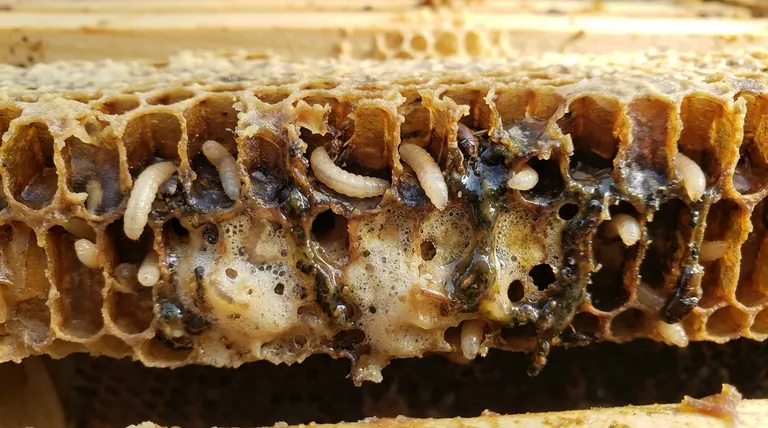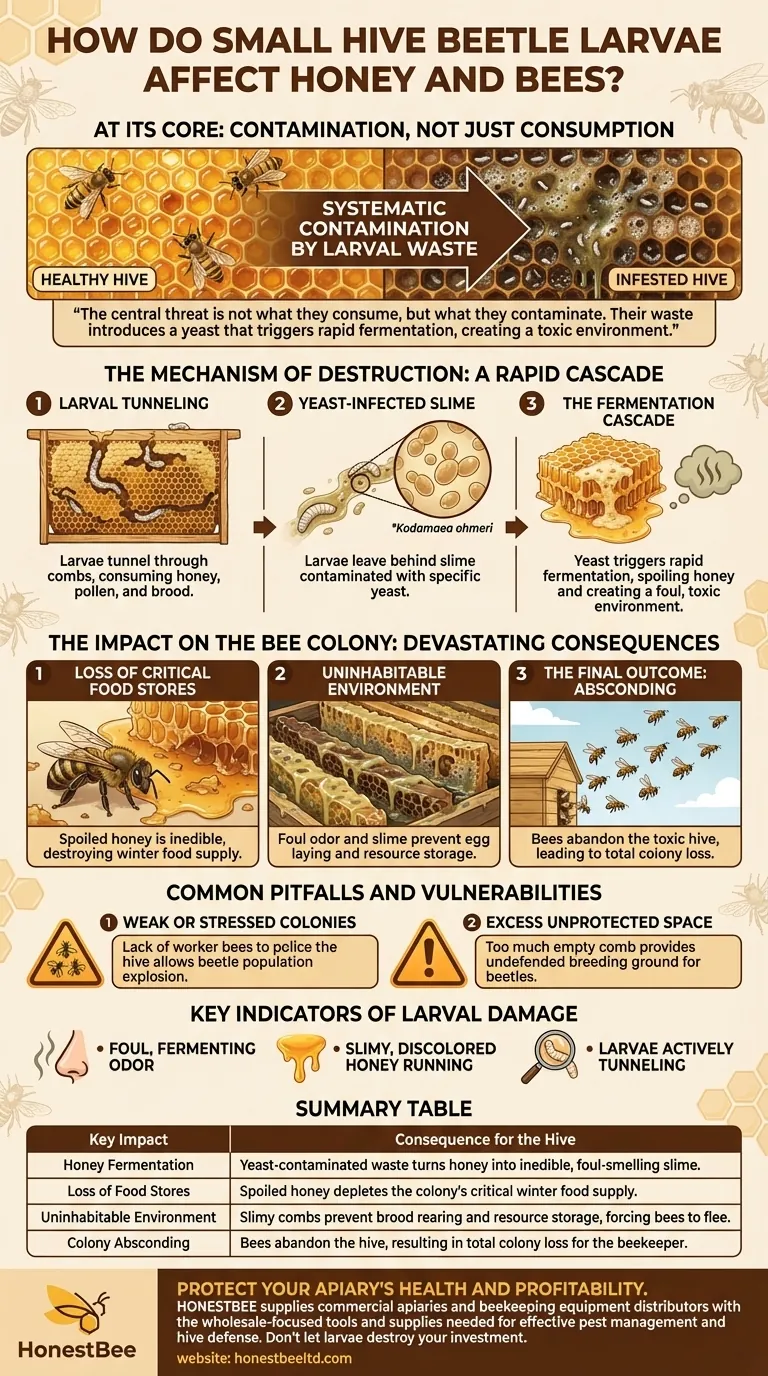At its core, small hive beetle larvae destroy a honey bee colony from the inside by systematically contaminating its food supply. Their waste product introduces a specific yeast that ferments the honey, turning it into a foul-smelling slime that is inedible to bees and ultimately drives them to abandon the hive.
The central threat of small hive beetle larvae is not what they consume, but what they contaminate. Their waste introduces a yeast that triggers a rapid fermentation of the hive's honey stores, creating a toxic environment that can lead to total colony loss.

The Mechanism of Destruction: From Larva to Fermentation
To understand the severity of this pest, you must first understand the process. The damage is a rapid, cascading failure that begins with the larvae hatching and ends with a ruined hive.
The Larval Tunneling
The larvae begin their destructive work by tunneling through the combs. They consume honey, pollen, and even the bees' own brood (eggs and pupae).
This initial feeding behavior is damaging on its own, but it is the secondary effect that causes the most harm.
The Critical Contaminant: Yeast-Infected Slime
As the larvae tunnel and feed, they leave behind a trail of waste, or "slime." This is not just simple waste; it is contaminated with a specific yeast, Kodamaea ohmeri.
The larvae and this yeast have a symbiotic relationship. The yeast helps break down the food for the larvae, and the larvae act as a vector, spreading the yeast throughout the hive.
The Fermentation Cascade
Once introduced into the honey, the yeast begins a rapid fermentation process. This changes the chemical composition of the honey, spoiling it completely.
The affected honey becomes frothy and discolored, often running out of the comb cells. It develops a characteristic odor often described as smelling like rotting oranges or decaying fruit.
The Impact on the Bee Colony
The fermentation cascade has devastating consequences for the honey bees, attacking their food, their home, and their ability to survive.
Loss of Critical Food Stores
The fermented, slimy honey is no longer a viable food source for the bees. A severe infestation can destroy a colony's entire winter food supply in a very short time.
An Uninhabitable Environment
The pervasive slime and foul odor create an environment that is toxic and repulsive to the highly hygienic honey bees. The mess coats the combs, making it impossible for the queen to lay eggs or for workers to store new resources.
The Final Outcome: Absconding
When an infestation becomes severe, the bees' only remaining survival strategy is to flee. This mass exodus is known as absconding.
The colony abandons the contaminated hive, leaving behind the ruined honey, comb, and any remaining brood to die. For the beekeeper, this means a total loss of the colony.
Common Pitfalls and Vulnerabilities
Not every hive is equally susceptible to this level of destruction. The beetles exploit specific weaknesses within a colony.
Weak or Stressed Colonies
A strong, populous colony has enough worker bees to "police" the hive. They can often trap and imprison adult beetles in "prisons" made of propolis and aggressively remove larvae they find.
Weak or queenless colonies lack the workforce to mount an effective defense, allowing the beetle population to explode unchecked.
Excess Unprotected Space
Hives with too much empty comb or supers of honey that are not yet occupied by a critical mass of bees provide a perfect, undefended breeding ground for the beetles. The adult beetles can lay eggs where there are few bees to find and remove them.
Key Indicators of Larval Damage
Recognizing the signs of this damage is crucial for any beekeeper aiming to prevent colony loss. Your response must be guided by what you observe.
- If you detect a foul, fermenting odor: This is the primary sign of advanced honey spoilage and a severe infestation.
- If you see slimy, discolored honey running on combs: This confirms the fermentation process is underway and the larval damage is significant.
- If you observe larvae actively tunneling through comb: The infestation is established, and immediate intervention is required to prevent widespread colony failure.
Vigilant monitoring for these signs is the key to protecting a colony from this destructive pest.
Summary Table:
| Key Impact | Consequence for the Hive |
|---|---|
| Honey Fermentation | Yeast-contaminated waste turns honey into inedible, foul-smelling slime. |
| Loss of Food Stores | Spoiled honey depletes the colony's critical winter food supply. |
| Uninhabitable Environment | Slimy combs prevent brood rearing and resource storage, forcing bees to flee. |
| Colony Absconding | Bees abandon the hive, resulting in total colony loss for the beekeeper. |
Protect your apiary's health and profitability. A small hive beetle infestation can lead to devastating losses. HONESTBEE supplies commercial apiaries and beekeeping equipment distributors with the wholesale-focused tools and supplies needed for effective pest management and hive defense. Don't let larvae destroy your investment—contact our experts today to fortify your operation.
Visual Guide

Related Products
- Reusable Clear Small Hive Beetle Traps for Beehives Beetle Trapping Tools
- Black Plastic Beetle Barn Hive Beetle Trap for Beehives
- Removable Washable Hive Beetle Trap Attractants for Small Hive Beetles
- Plastic Beetle Blaster Trap Beekeeping Tools and Supplies
- Professional Galvanized Hive Strap with Secure Locking Buckle for Beekeeping
People Also Ask
- What tips can help prevent hive beetle infestations? Build Strong Colonies & Master Apiary Hygiene
- Why are hive beetle traps important for beekeepers? Protect Your Hive from a Devastating Infestation
- What is the recommended number of beetle traps per hive? Optimize Your Hive's Beetle Defense
- What are the steps for installing hive beetle traps? A Guide to Effective Beetle Control
- What are the advantages of handheld beetle blasters and traps? Simple, Chemical-Free Hive Protection



















